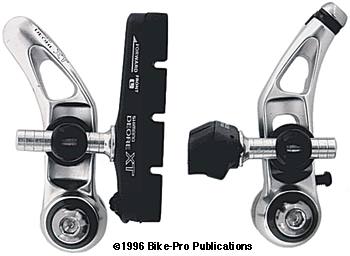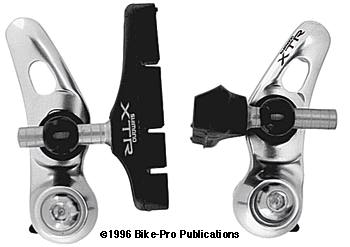

The M737 cantilever is very low profile and new for the 1994 model year. It uses the new Super M70 cartridge brake shoe allowing the user to change the brake pad only.when it wears out. (Read more about in the brake pad section of this article.)
Mechanical explanation of the XT brake. Each of the brake arms is forged of aluminum, polished on its front face, then clear anodized to a Silver. Each arm's internal tension spring (which pushes the arms out) is self contained and unable to be replaced. The steel tubing which functions as its axle, is crimped at both ends closing and locking the plastic shrouds, sealing the spring mechanism, and the spring permanently to the arm. Shimano uses five steel parts (the pad holder, both adjusting washers, a flat fixing washer and the 6mm x 1mm x 10mm hex tightening nut) to hold and pivot the brake pad. The brake pad is mounted to the front of the arm. The steel pad holder piece has a weight of 9 grams, the 10mm nut weighs 2 grams. (There are two possible Titanium replacements for the pad holder, our part number 06-91-PH-94, or 06-91-PH-ST, both are available at the end of the article.)
The M737 uses a clever wire carrier. At the cable carrier center is a aluminum pivot which holds a fixed length straddle wire, (the 80mm long "A" length cable for the front and the 90mm "B" length cable for the rear). The straddle wire has lead (Pb) anchors at both ends. One of these lead ends fits into the top of left brake arm. The brake cable inner wire passes into the top of the wire pivot and is turned smoothly down, and toward the right arm using a coiled, stainless steel, wire tube. This wire tube works like cable housing without the plastic exterior. Lubricating the inner wire inside of this coiled length can be performed by merely dropping oil through the coiled steel. The brake wire is fastened to the top of the right arm with a nickel plated steel with a 6mm hex fitting. The bolt has 6mm x 1mm threads , an 11mm length, weighing 3.5 grams. Once the cable is tightened, balance of the spring tension is performed with a small screw driver by an adjusting screw on the base of the right arm. End of mechanical.
Two steel bolts are included to tighten the arms to the mounting studs. The bolts have a mushroom head with a 5mm hex fitting and have 6mm x 1mm threads that are 25mm long. Each of these bolts weigh 6.5 grams. The brake pads weigh 56 grams per pair. We found the M737 cantilever had Bike-Pro brake profile measurement of 54mm. The M737 comes as front or rear. The brake weighs 175.5 grams. To this add 13 grams for the mounting bolts, and 10.5 grams for the rear cable carrier, or 10 grams for the front carrier. The total weight for the rear is 199 grams or the front is 198.5 grams.
Rear M737 cantilever $ Price in Catalog
Front M737 cantilever $ Price in Catalog

You should read the XT review before this LX review. The LX is a low profile brake, released in this version, in the 1993 model year. These brake arms are the basis of the new 1994 M737 XT canti brake. There are many similarities with the XT, and again remember the LX was first.
Mechanical explanation of the LX brake. The LX arms are painted Black, instead of being polished and anodized. The cable fastens to the top of the right arm using the same bolt as the XT, in the same place. The spring mechanism on both LX arms are enclosed and permanently sealed with plastic shrouds. Like the XT, the right arm has the single, identical adjustment of the spring tension balance, using a small screw. Really, if you remove the pad holding hardware and ignore the color, the left arm of the LX weighs 37 grams, just like the XT left arm. If you remove the pad holding hardware from the right arm, the LX right arm weighs 46 grams and so does the XT right arm. The same steel parts are used to hold the brake pad except the threaded pad holding piece itself. The LX uses a barrel shaped holder, while the XT used a bulbous rounded shape. The steel LX pad holder weighs 8.5 grams while the XT weighs 9 grams, so there was no weight improvement from is near cosmetic change. The shape change makes it more difficult to loose the steel pad holding base washer (or front washer).
The LX cable carrier also closely resembles that used in the XT, (wouldn't it have to, if the entire rest of the design was the same?) An aluminum pivot is again used with a fixed length straddle wire and leaded ends on one side A coiled steel wire is used to guide the brake inner wire to the cable fastening bolt to the top of the right arm. The coiled wire has a Grey plastic exterior, with a 3.5mm outer diameter like derailleur wire housing. Not using the stainless steel of the XT model reduces by at least a gram the weight of the carrier. An "A" (front) and "B" (rear) carrier are again used with the same wire lengths. The LX comes with two of the same 25mm steel mounting bolts.
The brake pads on the LX brake are molded with steel re-enforcement, and a non-threaded aluminum mounting post. These are a "M-system" pad of modest quality, with a hardness of A/93. They aren't the equal of the M-System replacement pads (06-12-170-M, which have a larger surface area and are more rigid). So, what we've found is the coiled wire on the cable carrier is stainless steel on the XT, the XT has a polished Silver front face and the XT comes with a newer brake pad style. However, if you can live with a Black rather than Silver brake, you can buy the LX and a pair of Scott/Mathauser finned brake pads and still save about $9. Consider it strongly, the big game in imported bike parts from Japan (because of endaka, high yen, and a generally weak domestic economy) is to make tiny changes as "improvements" let them go as un-noticed in the older model while you charge dearly for a "new" version.
The included brake pads weigh 50 grams per pair bringing the brake to a 191 gram weight. Remember, the LX brake & Scott finned pads is less expensive than XT and is probably a superior combination and be 15 grams lighter.
Rear M560 cantilever $ Price in Catalog
Front M560 cantilever $ Price in Catalog

The M900 cantilever has cold forged arms for strength. Cold forging takes rough aluminum shapes and squeezes them using dies to successively bring them to the desired shape.
Mechanical explanation of the XTR brake. The arms are a low profile design and made hollow to reduce weight where possible. The arms are polished after forging and clear anodized to make them Silver. The M900 comes in the 1994 model year with one-piece molded brake pads that have steel reinforcements and an aluminum mounting post. In the 1995 model year Shimano will sell the M900 with the M-70 pad used on the 1994 XT. Please read about them in the Brake Pad section of this article. Each arm's internal tension spring and the bushings they revolve are accessible. The pivot axle is made of carefully machined steel that slides inside a Teflonª lined outer sleeve with copper bushings. The right arm has a single adjusting screw to balance the spring tension between the arms. This cap screw has a recessed 2mm hex fitting and the needed 2mm hex wrench isn't provided. The brake pad is mounted to the front of the arm.
The M900 uses a five parts to hold and pivot the brake pad. Four of them, the pad holder piece, the pad holding base washer, a flat washer and the tightening nut are made of steel. Shimano makes from aluminum the concave rear washer. Any of the 3 SRP Ti replacement pad holders can work to replace the steel ones used on the M900. The XTR cable carrier is what might be called "semi-traditional". It uses a steel straddle wire with lead anchors at both ends. One of the lead ends fits into the top of the left arm, the other is held securely by the carrier. The carrier is made of two aluminum plates that are held together by a small steel bolt with a 5mm hex fitting that is cinched by an 8mm steel hex nut. The carrier steel bolt set weighs 3.5 grams. The brake cable inner wire passes through the carrier between the plates and rubs against the steel bolt. When the cable is tightened the carrier's pitch is changed smoothing the cable's transition. The brake inner wire is cinched to the top of the right arm by a steel bolt with 5mm by .8mm pitched threads with a 9mm length. This bolt has an 8mm outer hex head and a 2.5 gram weight. Each M900 comes with two steel 6mm by 1mm mounting bolts that are 14.5mm long and two aluminum washers that close off the top of the brake's pivot. Each of the steel bolts weighs 3.75 grams. The brake pads weighs 45 grams. End of mechanical.
We found the M900 cantilever had a Bike-Pro brake profile measurement of 51mm. The M900 comes as a front or rear based on the length of the straddle wire. The brake weighs 157.5 grams. To this add 7.5 grams for the mounting bolts and 12 grams for the rear cable carrier, or 11.5 grams for the front carrier. The total weight of the M900 rear is 177 grams, or for the front 176.5 grams. Although this is a fairly lightweight brake by mass produced standards, SRP has an 18 piece Ti replacement kit for XTR brakes. These pieces replace 18 steel ones used if you happen to use an XTR brake on both the front and rear of your bike. Read about it toward the end of this article.
Front M900 cantilever $ Price in Catalog
Rear M900 cantilever $ Price in Catalog

This was introduced in the 1996 model year